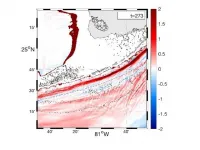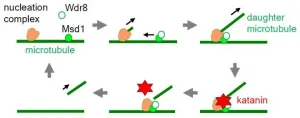Using a numerical model that simulates ocean currents, researchers from Florida Atlantic University's Harbor Branch Oceanographic Institute and collaborators from the Alfred-Wegener-Institute in Germany and the Institut Universitaire Europeen De La Mer/Laboratoire d'Océonographie Physique et Spatiale in France are shedding light on this important "motion of the ocean." They have conducted a first-of-its-kind study identifying the mechanisms behind the formation of sub-mesoscale eddies in the Straits of Florida, which have important environmental implications.
Despite the swift flow of the Florida Current, which flows in the Straits of Florida and connects the Loop Current in the Gulf of Mexico to the Gulf Stream in the Western Atlantic Ocean, eddies provide a mechanism for the retention of marine organisms such as fish and coral larvae. Since they trap the nutrient rich West Florida Shelf waters, they provide habitat to many reef and pelagic species within the region of the Florida Keys Reef Track, which sustains the very high productivity of this region.
Moreover, despite the tendency of the West Florida Shelf to overflow into the Straits of Florida, the formation of eddies provides a mechanism that limits the cross shelf transport of nutrient-laden waters. As a result, the formation of eddies stops the export of the West Florida Shelf waters across the Straits of Florida, preventing events such as red tides from crossing over to Cuba or the Bahamas. Conversely, toxic red tide waters emanating from the shelf remain longer in the vicinity of the Florida Keys Reef Tract coral reef ecosystem, adversely affecting the ecosystem's health.
These small-scale frontal eddies are frequently observed and present a wide variety of numbers, shapes, and sizes, which suggest different origins and formation mechanisms. Their journey through the Straits of Florida is at time characterized by the formation and presence of mesoscale, but mostly sub-mesoscale frontal eddies on the cyclonic side of the current.
The study, published in the Journal of Physical Oceanography, provides a comprehensive overview and understanding of the Straits of Florida shelf slope dynamics based on a realistic two-way nested high-resolution Regional Oceanic Modeling System (ROMS) simulation of the South Florida oceanic region. The full two-way nesting allowed the interaction of multiscale dynamics across the nest boundaries.
Results showed that the formation of the sub-mesoscale frontal eddies in the Straits of Florida are associated with the sloshing of the Florida Current, which consists of the oscillation of the distance of the current core from the shelf. When the Florida Current core is pushed up against the shelf, the shear on the shelf increases and sub-mesoscale frontal eddies can be formed by barotropic instability. When this position is relaxed, baroclinic instability instead is likely to form sub-mesoscale eddies. Unlike barotropic instability, which is shear driven, baroclinic instability is driven by changes in density anomalies.
"In the Straits of Florida, eddies smaller than their open ocean relative are formed. Those eddies, called sub-mesoscale eddies, are common and can be easily observed in ocean color imagery," said Laurent Chérubin, Ph.D., senior author and an associate research professor, FAU Harbor Branch. "Unlike the larger open ocean mesoscale eddies, they are not in geostrophic balance, meaning that their circulation is not sustained by the balance between the pressure gradient and the Coriolis forces. Instead, some of the frontal eddies in the Straits of Florida are in gradient wind balance, which indicates that a third force, the centrifugal force, is large enough to modify the geostrophic balance."
The Florida Current is part of the western branch of the wind driven north Atlantic anti-cyclonic gyre, which is intensified on the western side of the North Atlantic basin in comparison to its eastern side. Similar types of currents also are found on the western side of ocean basins such as the Agulhas current in the southern Indian Ocean or the Kuroshio in the northern Pacific Ocean. They are called boundary currents because they impinge on the continental shelf and as such, they undergo a significant amount of friction on the ocean floor. This friction, which acts vertically and horizontally on the boundary current, contributes to the formation of a sheared boundary layer.
"Our study shows that this shear layer can become unstable and form eddies. This process is in fact a pathway for the dissipation of wind energy injected in the ocean. Therefore, in the Straits of Florida, eddies smaller than their open ocean relative are formed," said Chérubin.
In addition to sub-mesoscale eddies formed locally in the Straits of Florida, there are incoming mesoscale eddies that transit in the Straits of Florida, such as the Tortugas Gyre.
"Findings from our research also show that mesoscale eddies can be squeezed on the shelf and transformed into sub-mesoscale eddies when the Florida Current is in its protracted position or remains relatively unaffected if the Florida Current is retracted from the shelf," said Chérubin.
INFORMATION:
Study co-authors are Nicolas Le Paih, a Ph.D. student in physical oceanography, Alfred-Wegener-Institute; and Xavier Carton, Ph.D., a professor at the Institut Universitaire Europeen De La Mer/ Laboratoire d'Océonographie Physique et Spatiale.
This study was supported in part by NOAA grant "Coastal and Ocean Climate Applications" (NA12OAR4310105) and by the Harbor Branch Oceanographic Institute Foundation.
About Harbor Branch Oceanographic Institute:
Founded in 1971, Harbor Branch Oceanographic Institute at Florida Atlantic University is a research community of marine scientists, engineers, educators and other professionals focused on Ocean Science for a Better World. The institute drives innovation in ocean engineering, at-sea operations, drug discovery and biotechnology from the oceans, coastal ecology and conservation, marine mammal research and conservation, aquaculture, ocean observing systems and marine education. For more information, visit http://www.fau.edu/hboi.
About Florida Atlantic University:
Florida Atlantic University, established in 1961, officially opened its doors in 1964 as the fifth public university in Florida. Today, the University serves more than 30,000 undergraduate and graduate students across six campuses located along the southeast Florida coast. In recent years, the University has doubled its research expenditures and outpaced its peers in student achievement rates. Through the coexistence of access and excellence, FAU embodies an innovative model where traditional achievement gaps vanish. FAU is designated a Hispanic-serving institution, ranked as a top public university by U.S. News & World Report and a High Research Activity institution by the Carnegie Foundation for the Advancement of Teaching. For more information, visit http://www.fau.edu.





